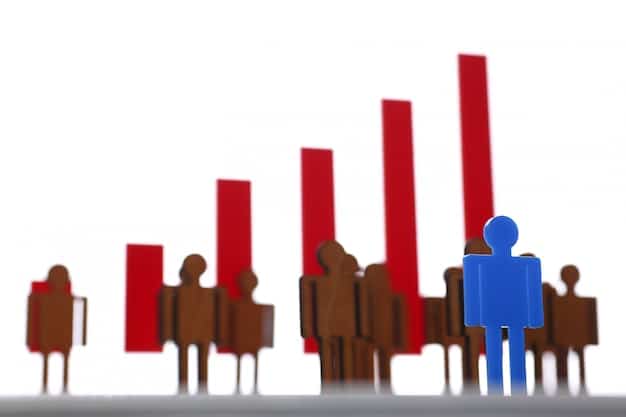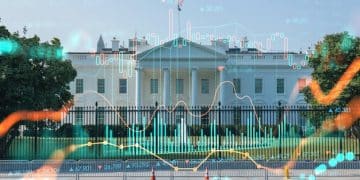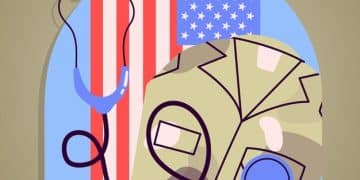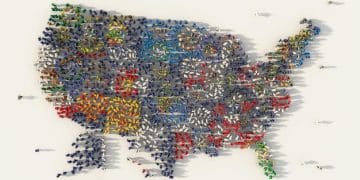Analyzing the Latest US Unemployment Rate: What It Means for the US Economy

Analyzing the Latest US Unemployment Rate: A rate of 3.7% reflects a generally stable labor market, but understanding its implications requires examining factors like labor force participation, wage growth, and potential impacts on economic growth and Federal Reserve policies.
The latest US unemployment rate stands at 3.7%, a figure that prompts many questions about the health and future of the American economy. Understanding what this number truly signifies requires a deeper dive into the underlying economic factors and potential consequences. Analyzing the Latest US Unemployment Rate: What Does 3.7% Mean for the Economy? This analysis will explore various aspects of the current situation, from labor force participation to potential impacts on economic growth.
Let’s explore the nuances behind the latest unemployment figures and how it shapes the financial landscape.
Understanding the Basics of the Unemployment Rate
The unemployment rate is a critical economic indicator that reflects the percentage of the labor force that is currently unemployed and actively seeking employment. It’s a key metric watched by economists, policymakers, and investors alike.
How the Unemployment Rate is Calculated
The Bureau of Labor Statistics (BLS) calculates the unemployment rate monthly. It is derived from a survey of households and establishments across the United States. The labor force includes those who are employed and those who are unemployed but actively looking for work.
Different Types of Unemployment
Understanding the types of unemployment helps provide a more nuanced perspective on the health of the labor market. There are several types of unemployment:
- Frictional Unemployment: This occurs when people are temporarily between jobs.
- Structural Unemployment: This results from a mismatch between the skills workers have and the skills employers need.
- Cyclical Unemployment: This is tied to the business cycle, increasing during recessions and decreasing during expansions.
- Seasonal Unemployment: This is due to seasonal variations in employment.
In conclusion, the unemployment rate is not just a number; it’s a reflection of the overall health of the labor market and the economy as a whole. Understanding its components and how it’s calculated is essential for interpreting its significance.

Analyzing the Latest US Unemployment Rate: What Does 3.7% Mean for the Economy?
The latest unemployment rate of 3.7% presents a mixed picture. While it is relatively low compared to historical averages, it’s essential to delve deeper into what this figure signifies for the economy. The rate is slightly above recent lows, indicating some shifts in the labor market.
The Significance of 3.7% Unemployment
An unemployment rate of 3.7% generally indicates a tight labor market. However, several underlying factors can influence its interpretation. These include:
- Labor Force Participation Rate: This measures the proportion of the population that is either employed or actively seeking employment.
- Wage Growth: This reflects the rate at which wages are increasing, which can indicate the strength of demand for labor.
- Job Openings: The number of unfilled job positions can signal whether employers are struggling to find qualified workers.
Factors Impacting the Unemployment Rate
Several factors can contribute to changes in the unemployment rate. These include technological advancements, shifts in industry demand, and government policies:
- Technological Advancements: Automation and artificial intelligence can displace workers in some sectors, potentially increasing unemployment.
- Industry Shifts: Changes in consumer demand and global economic trends can lead to job losses in declining industries and job creation in growing ones.
- Government Policies: Policies related to trade, immigration, and labor laws can significantly impact employment levels.
Ultimately, analyzing the unemployment rate requires considering several factors beyond just that single number. It’s a complex indicator influenced by a multitude of interacting forces.
How the Unemployment Rate Affects Different Sectors
The unemployment rate does not affect all sectors equally. Some industries are more sensitive to economic fluctuations and see greater employment volatility.
Sectors Sensitive to Unemployment
Certain sectors are more vulnerable to unemployment based on their sensitivity to economic cycles and consumer demand:
- Construction: This sector is highly cyclical, with demand for construction projects often declining during economic downturns.
- Manufacturing: Manufacturing jobs are often affected by changes in consumer spending and international trade.
- Retail: Retail jobs are sensitive to consumer confidence and spending patterns, making them susceptible to unemployment fluctuations.
Sectors Less Sensitive to Unemployment
Conversely, certain sectors tend to be more resilient during economic downturns:
- Healthcare: Healthcare is generally considered a necessity, making it less susceptible to economic fluctuations.
- Education: Education services tend to remain stable, as demand for schooling remains relatively constant.
- Government: Government jobs often provide stability, as public services continue regardless of economic conditions.

In short, the impact of the unemployment rate varies significantly across industries, reflecting differences in economic sensitivity and sector-specific factors.
The Relationship Between Inflation and Unemployment
The relationship between inflation and unemployment is a central topic in economics. The Phillips Curve, for example, suggests an inverse relationship between inflation and unemployment. However, this relationship is complex and not always consistent.
Understanding the Phillips Curve
The Phillips Curve posits that lower unemployment rates are associated with higher inflation rates, and vice versa. This theory suggests that as the labor market tightens, employers must offer higher wages to attract workers, leading to increased prices for goods and services.
The Current Economic Scenario
In the current economic environment, the relationship between inflation and unemployment is particularly relevant. High inflation rates have prompted the Federal Reserve to implement monetary policies aimed at cooling the economy. These policies can have implications for the unemployment rate.
Currently analyzing the Latest US Unemployment Rate: What Does 3.7% Mean for the Economy? It is crucial to understand that monetary policy decisions are based on the interplay between these two key macroeconomic indicators.
To sum up, the interplay between inflation and unemployment is a critical consideration for policymakers, requiring careful calibration of monetary and fiscal policies to achieve economic stability.
Future Projections and Potential Scenarios
Forecasting the future unemployment rate involves considering several potential economic scenarios. These projections are inherently uncertain but provide a basis for anticipating potential challenges and opportunities.
Potential Economic Scenarios
Several factors could influence the future trajectory of the unemployment rate:
- Continued Economic Growth: If the economy continues to grow at a steady pace, the unemployment rate could remain low or decrease further.
- Economic Slowdown: An economic slowdown or recession could lead to a rise in the unemployment rate.
- Policy Changes: New government policies related to trade, taxation, or labor regulations could also impact employment levels.
Expert Opinions and Forecasts
Economists offer various forecasts for the future unemployment rate, based on different models and assumptions. Some predict a modest increase in the unemployment rate as the Federal Reserve continues to tighten monetary policy. Others anticipate that the labor market will remain resilient.
In conclusion, while projections vary, it’s clear that the future unemployment rate will depend on a complex interplay of economic conditions and policy decisions. Analyzing the Latest US Unemployment Rate: What Does 3.7% Mean for the Economy? It will remain a critical metric to watch.
| Key Point | Brief Description |
|---|---|
| 📊 Unemployment Rate | Current rate is 3.7%, indicating a tight labor market. |
| 💼 Sector Impact | Varies across sectors; construction & retail are more sensitive. |
| 📈 Inflation Link | Phillips Curve suggests low unemployment can drive inflation. |
| 🔮 Future Outlook | Dependent on economic growth, policy changes, and expert analysis. |
Frequently Asked Questions
Economists generally consider an unemployment rate between 4% and 5% to be healthy, indicating full employment or near full employment. However, what is deemed “good” can vary based on economic conditions.
The Federal Reserve influences unemployment through monetary policy. By adjusting interest rates and reserve requirements, the Fed can stimulate or cool down the economy, impacting job creation and unemployment levels.
A 3.7% unemployment rate suggests relatively high job security. With a tight labor market, employers often work harder to retain employees, decreasing the likelihood of layoffs and increasing job opportunities.
The unemployment rate doesn’t count people who are underemployed, have given up looking for work, or are employed part-time but desire full-time work. Therefore, it provides an incomplete picture.
Individuals can prepare by building an emergency fund, acquiring in-demand skills and certifications, networking, and maintaining an updated resume. Staying informed about industry trends is also beneficial.
Conclusion
In conclusion, analyzing the latest US unemployment rate of 3.7% reflects a complex interplay of economic forces. While the rate indicates a relatively healthy labor market, understanding its implications requires considering various factors such as labor force participation, wage growth, and sector-specific impacts.





